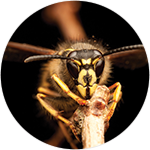 As summer slowly comes to an end, stinging insects such as paper wasps, bald-faced hornets and yellow jackets enter into their most active season in September
As summer slowly comes to an end, stinging insects such as paper wasps, bald-faced hornets and yellow jackets enter into their most active season in September
“Many people think that stinging insects are most active in June and July, but stinging insects are actually most aggressive in the early fall as the colony size has peaked and natural food sources start to decline, driving these insects to interact with humans more frequently,” said Patricia Hottel, technical director for McCloud Services. “Come autumn, stinging insect colonies in the Midwest can contain upwards of 4,000 members, leading to an increased number of stings as they tend to forage on human food.”
The National Pest Management Association (NPMA) reports that more than 500,000 people are sent to the emergency room every year due to insect stings. Some stings can also cause severe allergic reactions. McCloud Services encourages people to be on the lookout for stinging insects when attending late summer picnics or completing home maintenance projects around the yard this fall.
Follow these tips if you encounter stinging insects in your yard:
-
If possible, treat nests on the property to reduce workers and next year’s queens. If a nest is found on the property, McCloud Services recommends calling a licensed pest professional for assistance. If a nest can be found and treated, it will reduce the risks of foraging wasps.
-
Consider the use of traps to reduce numbers. Place traps around the perimeter of the area you are trying to protect. They should not be placed where people are likely to contact.
-
Cover food as much as possible when grilling and serving food outdoors. Cups with lids can help discourage yellow jackets and prevent encounters.
-
Keep outside garbage in sealed bags and trash receptacles with self-closing lids.
